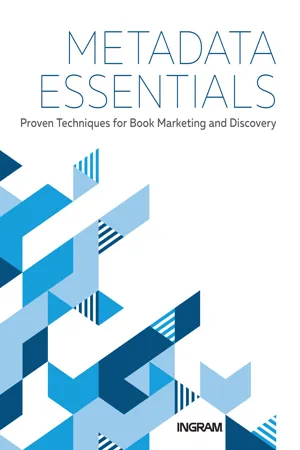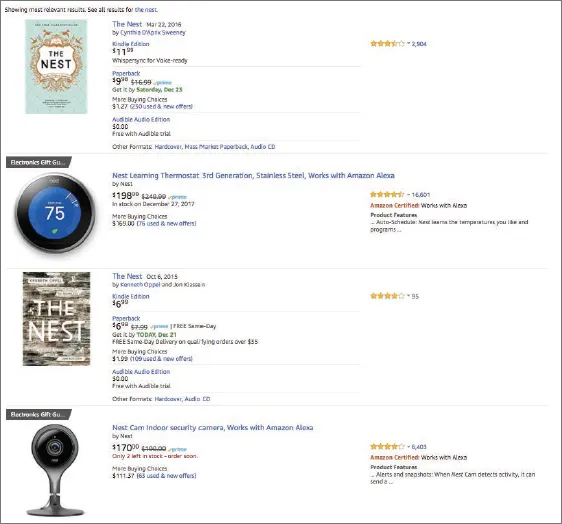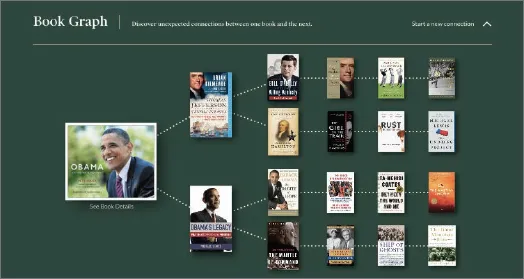
eBook - ePub
Metadata Essentials
Proven Techniques for Book Marketing and Discovery
This is a test
- English
- ePUB (mobile friendly)
- Available on iOS & Android
eBook - ePub
Metadata Essentials
Proven Techniques for Book Marketing and Discovery
Book details
Book preview
Table of contents
Citations
About This Book
"... An essential, unique, and thoroughly 'user friendly' instructional reference and guide that should be an integral part of every author and every publisher's professional book marketing plan instructional reference collection." - Midwest Book Review
Metadata Essentials: Proven Techniques for Book Marketing and Discovery provides clear and easy-to-implement recommendations so you can focus your efforts on the industry's most relevant metadata.
Based on direct feedback from retailers and librarians, Metadata Essentials unlocks insights into the value and real-life uses of the metadata you spend so many precious hours editing and curating. Because it does matter.
- Enhance the metadata that yields proven results
- Boost title discovery
- Increase online conversion rates
- Save time and money
Frequently asked questions
At the moment all of our mobile-responsive ePub books are available to download via the app. Most of our PDFs are also available to download and we're working on making the final remaining ones downloadable now. Learn more here.
Both plans give you full access to the library and all of Perlego’s features. The only differences are the price and subscription period: With the annual plan you’ll save around 30% compared to 12 months on the monthly plan.
We are an online textbook subscription service, where you can get access to an entire online library for less than the price of a single book per month. With over 1 million books across 1000+ topics, we’ve got you covered! Learn more here.
Look out for the read-aloud symbol on your next book to see if you can listen to it. The read-aloud tool reads text aloud for you, highlighting the text as it is being read. You can pause it, speed it up and slow it down. Learn more here.
Yes, you can access Metadata Essentials by Jake Handy, Margaret Harrison, Jess Johns, Jess Johns in PDF and/or ePUB format, as well as other popular books in Languages & Linguistics & Library & Information Science. We have over one million books available in our catalogue for you to explore.
Information
CHAPTER 1: How Books are Discovered
Search engine optimization is critical to success in today’s market, and metadata is the key to making your book discoverable to consumers. In this chapter, we’ll help you understand how Amazon’s search algorithm works and which metadata elements are essential to help place your book among top search results for relevant queries. We’ll also examine the potential for exploiting smart searching at other online bookstores.
Think about how a consumer might have stumbled across a good book in a bookstore or library in the 1990s. If a publisher has paid for advertising, the book might be featured in a bookstore in a display. A bookseller or a librarian might provide a recommendation. A book cover might catch the eye of a discerning browser, prompting that reader to pick up the book, inspect the back cover and jacket flaps, and flip through the pages. A reader might go to a particular section or shelf, such as Italian cookbooks, and look for a title of interest, probably based on the title name on the spine of the book.
These discovery experiences still happen today, but consider how limited each experience is. It’s limited to the inventory on the shelf, selected by a buyer or librarian. It’s limited to the knowledge of my bookseller or librarian. It’s limited to the publishers who have advertising budgets.
Enter search engine optimization. The internet has opened a floodgate of opportunity for authors and publishers through the ability to enable long-tail discovery. True, you’ll still compete against ad dollars, online and in-store, and you’ll compete against well-known brands. But you’re no longer limited by the knowledge or budget of a bookseller or librarian. By ensuring your book can be returned in the top search results of relevant online queries, you can connect with more readers than you ever imagined. This takes some practice. It also requires an understanding of how search engines work.
Note: Because this is a book about metadata, we focus on the role that metadata plays in Amazon search results and at other bookstores and libraries. SEO is a much broader topic, and you may have some interest in optimizing your website for Google search results, but we won’t cover that in depth here in this book, though by following our guidelines you may find that your product detail pages at retailers and on your own site achieve better rankings at Google and other online search engines. For more on general website optimization, we recommend you start with an SEO resource like Moz (moz.com) where you’ll find a robust and broad SEO toolkit for site content optimization.
During the rest of this chapter, and throughout the book, we’ll focus on optimizing the search results of your books on retail, library, and other discovery websites. Because these are product-driven searches (generally, people go to retail sites because they want to buy something), rather than question-driven (generally, people perform online searches to have a question answered, which may or may not be product-driven), the search journey is somewhat different.
Not all search engines are created equal. As you’ll learn, Amazon is the most sophisticated retail search engine by far, but it’s important to understand how search engines contribute to the book-discovery process across the book landscape so you can improve the odds of your title coming up in every relevant search, whether at Amazon, Booktopia in Australia, or OverDrive for library patrons.
How Amazon Search Works
Amazon’s search algorithm is called A9. As we’ve observed, unlike Google’s search algorithms, designed to provide the most accurate answer to your question, Amazon is singularly focused on getting you to buy as much as possible on the site. To achieve this, Amazon has designed A9 to call up the products that are relevant to you and also the products you are most likely to buy. Accordingly, key factors in Amazon search include:
• Click-through rate (CTR), measured by how often a consumer clicks through to a product page from search results
• Conversion rate, measured by how often a consumer who visits the product page actually purchases the product
• Overall sales, based on gross and net revenue to Amazon
• Keyword relevance, measured by the degree a product matches a search for a keyword
A unique and specific book title, such as The Hidden Life of Trees, will have better search relevance than a less unique book title, such as The Nest, which will share search results with other nonbook products.

FIGURE 3. Search results for The Nest at Amazon.com, captured December 2017.
There are many factors that contribute to search results at Amazon. It’s important to remember that an algorithm is a melting pot of all those factors, so you won’t always see a direct cause-and-effect outcome to changing your metadata for Amazon SEO. By familiarizing yourself with the various factors and search “markers,” you can give yourself the best odds of boosting your search results and sales.
For books, Amazon typically matches keyword search to title name first, followed by contributor and subtitle. But there are other factors as well, especially in a more congested search. Remember that Amazon is trying to make the most revenue possible—not just short-term, but long-term—and they want you to buy and be satisfied with your purchase so you’ll come back. In no particular order, here are other search factors at Amazon:
• Star reviews. Positive star ratings (4 or more stars) from Amazon customers are a search marker.
• Images. A high-resolution cover (at least 300 dpi and ideally 2560 x 1600 pixels) as well as a back cover and interior images may boost your search results.
• Bestseller status. #1 Bestseller status in a particular category at Amazon.
• Amazon participation. Participation in Look Inside, Kindle Unlimited and other Amazon programs, including paid ads and exclusivity. Remember, this is only a marker and may not in and of itself contribute to positive search results. You can try nonpaid and nonexclusive options before you go “all in” with an investment or exclusivity.
Metadata for Amazon Search
One of the most important things you can do to boost your SEO at Amazon is to create great metadata that will contribute to click-through rates and conversion rates. You’ll find more information on how Amazon uses metadata in Chapter 3 and more details on specific attributes that are important in Chapter 2. If you’re reading this book because you are specifically interested in optimizing for Amazon, check out the following sections in Chapter 2 that will make the biggest impact in Amazon search results:
• Titles, Series, and Editions
• Illustrations & Other Image Details
• Long & Short Descriptions
• Keywords
• Using BISAC & Other Subject Codes the Right Way
Beyond Amazon Search & Other Booksellers
You probably weren’t surprised to hear that Amazon’s search engine is far more sophisticated than any other bookstore. Consider, though, that when it comes to selling books, Amazon can be at a disadvantage: as the online “superstore,” Amazon must position books alongside millions of other products in a search, from dishwashers to diapers. A customer browsing for books by a particular phrase (also called a keyword) may find other products in search results.
A bookstore or book-focused site has the distinct advantage of focusing on the book-discovery journey. For example, Barnes & Noble has optimized their search engine as well as the web pages that display a book (called product detail pages) at bn.com to cater to the many consumers who are searching for particular book series on their site.
A book-focused site may have a landing page for a series or author or even a special promotion, such as a theme or a price promotion. Strand Books, an independent bookstore in New York City, often creates these custom landing pages on their website (strandbooks.com). These landing pages may come up in search results, or a customer searching for a particular author or series may be redirected to the page automatically, depending on the website. Of course, Amazon may do these pages as well, but given that books are merely one of hundreds of categories of other products on the site, they will be more focused on bestsellers and less focused on niche books or local content.
Typically, online booksellers and book websites return search results based on three key metadata elements:
• Title name (depending on the site, this may be a full or partial match)
• Author or contributor
• ISBN or EAN (the unique identifier for your book)
More sophisticated search engines may also index (or use as content for search results) the series, subtitle, subject, keywords, format (e.g., hardcover or ebook), or even book descriptions. A small number of book-search engines do factor in star ratings and images, but by and large, most are searching against the title, contributor, and ISBN. This is why, as we’ll cover in Chapter 2 and Chapter 3, it’s important to create a keyword-rich title, if at all possible. In the wide world of bookselling, it is your best shot at achieving that serendipitous online discovery from a consumer who would otherwise have never heard of your book.
While search beyond Amazon is fairly limited, there are many examples of brilliant bookselling and marketing out there on the web. Here are a few of our favorite examples:
• Barnes & Noble’s Book Graph. This feature, added to the B&N website during the fall of 2017, displays a map of related books based on metadata and B&N buyer recommendations. This is not the same as the “Customers who bought this product also bought” feature on many online retail sites, which is based on consumer buying behavior. Book Graph is truly based on the subject matter of the book, which may resonate more with book buyers.
• iBooks & print book searches. Even though the iBookstore only sells digital books, they index associated print books to ensure a consumer who might be searching Google or iBooks with a print ISBN can be connected to the appropriate ebook version. Google Play does this as well. (Read more about how to provide print and ebook ISBNs in your metadata in Chapter 3.)

FIGURE 4. Barnes & Noble Book Graph, launched in 2017, aims to make recommendations based on tastes, not purchase history.
• Jet.com and relevance. We’re really impressed by how tight the search results are becoming at Walmart-owned Jet.com. A search for “harry potter and the sorcerer’s stone” at most booksellers returns too few results or too many, but Jet.com returned a perfect 14 results, including the illustrated version and a French and Spanish language version, without any fake or irrelevant resu...
Table of contents
- Cover
- Title Page
- Copyright
- Contents
- Introduction
- Chapter 1: How Books are Discovered
- Chapter 2: Take Action! Metadata Essentials, Your Step-by-Step Guide
- Chapter 3: Major Bookseller Profiles
- Chapter 4: Metadata & Libraries
- Glossary
- Index